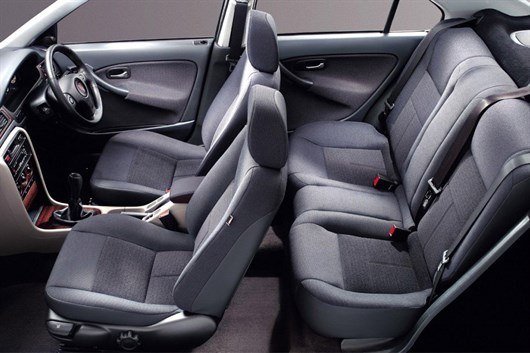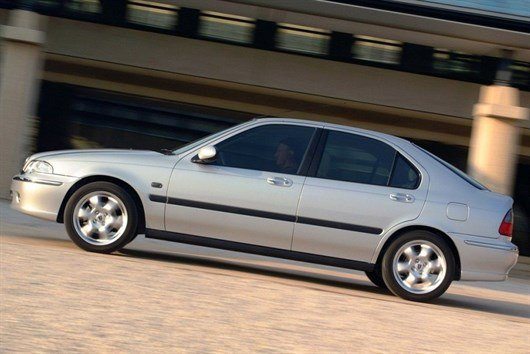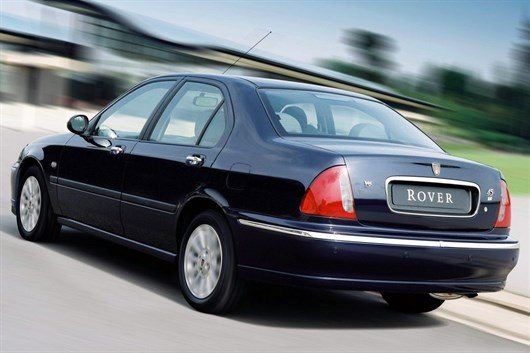Future Classic Friday: Rover 45

Here’s one for the pub quiz – what was the first new car to go on sale in the UK in the 21st century? The answer is the Rover 45, which arrived in showrooms during the first week of January 2000. Its sister car, the 25, was the last car to be launched in the 20th century, with an on sale date of December 1999, following their joint reveal at the London Motor Show the previous October.
So, next time anyone tries to tell you the Rover 45 isn’t a classic, point this nugget out to them…
Today, less than a quarter of the 45s built remain (though this is actually quite a good survival rate…), and while the car was never an out-and-out winner when new, it’s one that has aged gracefully and proven itself to be more resilient than many expected, even if it does languish – currently, at least – right in the penniless pit of bangerdom.
Based on the 1995 Rover 400, itself a repackaged Honda Civic, the model had more Honda content than previous cars from the collaboration between the two companies, even though BMW had taken over the reins at Longbridge before it even went on sale.

It’s rumoured, as a result, that Honda was deliberately obstructive to Rover’s development plans for the 400. While a Civic Aerodeck estate appeared, for example, there was never a replacement for the old-shape Rover 400 Tourer, while the four-door model needed extensive additional engineering from Rover’s own body development team before it went on sale, meaning the 400 was introduced as an incomplete line-up from the start. Honda also charged Rover full retail price for the D16 engine and automatic gearbox fitted to self-shifting 400s, making the company’s heartland of elderly motorists trickier to sell into.
By the time the 45 arrived, though, Rover had moved on. It was stuck for now at least, with the Honda architecture, but it had developed its own range of CVT transmissions in conjunction with German gearbox specialist ZF, along with new derivatives of the K-series engine such as the small capacity 2.0-litre KV6, used to great acclaim in the Rover 75.
It should be remembered, too, that the Rover 45’s five-year production run was twice as long as it should have been. The car was essentially a stop gap, to modernise the range and keep retail and fleet sales stable while a smaller car was derived from the much-lauded Rover 75 platform, but when BMW withdrew itself from Rover Group shortly after the 45’s launch, the development funds weren’t there to take it any further. The 45, then, was out-of-date when launched and antiquated by the time MG Rover finally fell on its sword in 2005.
Such a background doesn’t instantly scream ‘classic’. Indeed, in many respects the Rover 45 is the Austin Allegro of the 21st century – a car that’s so indicative of the problems faced by the British motor industry at the time of its launch that its flaws are laughable.

Compare a Rover 45 to a contemporary Volkswagen Golf or Ford Focus, for example, and the interior is almost comedic. The switchgear is a combination of flimsy 1980s carryover (see: column stalks) and uninspiring Japanese hatchback (see: awful window controls, heated rear window button), with a smattering of real, fake and ultimately formica wood, depending on how close it was to the car’s bitter end. Compared to its rivals, with their integrated design and soft-touch plastics, it wasn’t an inspiring place to be.
But, here’s the rub. Put a 2001 Rover 45 next to a 2001 Ford Focus or 2001 Volkswagen Golf and see which one of the three has the least rust, the best MoT pass rate and, ultimately, looks fit to survive another year despite whatever the British roads throw at it. Yes, the Rover 45 is an unbelievably hardy beast. Seriously. Have you ever seen a rusty one?
But what about the head gaskets, you may cry? Well, they go. It’s a common failure, or was when the cars were new. Today, most have been replaced with uprated items and those that haven’t gone probably won’t – the well-documented ‘HGF’ issue with the K-series engine was no worse than many other faults found in cars of the same era, and costs a lot less to put right than a broken clutch and dual mass flywheel on a diesel family saloon. But try telling that to the motoring press…
Early ones are very pleasant cars indeed, with seats carried over from the 75 saloon, and an exceptional ride quality that beats that of many a bigger car – ask NASA, which gave the 400/45 the best comfort rating of any car in the world during independent testing. There are intriguing high points, too, such as the 45 V6, a master feat of packing that was a wonderful curiosity, or the 113PS diesel model, which had faster in-gear acceleration than a BMW 325d. They drive tidily, too, as proven by the fact that the 45 became the MG ZS, the most unlikely but surprisingly well loved performance car of the 2000s.

Add in the fact that, because it looked ancient when it first came out, the 45 has actually aged far more gracefully than many of its contemporaries and you have a car that conceals many secrets, facets of its character and engineering that were buried beneath dire mismanagement and decades of soothsaying media coverage.
The 45 was ultimately a failure, and part of the contribution to MG Rover’s overall collapse. But was it a bad car? Given the fact its pro-rata survival rate is so much better than the equivalent Vauxhall Astra, Ford Focus or Volkswagen Golf, probably not. It was a pretty good car, launched a decade behind its time…
Comments
Compare classic car insurance quotes and buy online. A friendly service offering access to a range of policies and benefits.


 Craig Cheetham
Craig Cheetham
 NEC classic motor show 2020 postponed due to Covid 19 concerns
NEC classic motor show 2020 postponed due to Covid 19 concerns
 Classic car auction house Coys goes into administration
Classic car auction house Coys goes into administration
 Motor racing great Sir Stirling Moss dies aged 90
Motor racing great Sir Stirling Moss dies aged 90
 Alfa Romeo anniversary races set for Silverstone
Alfa Romeo anniversary races set for Silverstone
 Government to make E5 fuel available for classic owners
Government to make E5 fuel available for classic owners
 Plans to introduce cleaner fuel could damage more than a million classic cars
Plans to introduce cleaner fuel could damage more than a million classic cars
 Top 10: Classic cars from the Gulf motor racing heritage collection
Top 10: Classic cars from the Gulf motor racing heritage collection







meandering on 17 February 2018
Not such a good pub quiz question, as January 2000 occurred during the 20th CenturyHarrovian on 18 February 2018
My wife has a 2004 45, a 1.8 Impression S model with a number of extras, it's a CVT transmission car and is excellent. The car had done 9000 miles when we bought it in 2007, it's now done 60,000 and is 100% reliable, it's very fast when it needs to be and drives well, a bit of a 'Q' car in fact.We are Rover fans and know they are far superior to Fords, VW's and so on!
The only downside is the Road Tax, dear old Gordon Brown retrospectively increased the band and the cost just after we bought the car, which now costs around £300 a year to tax!
Sir Kevin Parr, Baronet on 19 February 2018
Ran a 45 tdi for 12 years not one fault. Serviced regularly driven all over Europe and easy on long journeys over land to Riga from Windermere UK. A car that was never in a garage other than for fuel or service. Still have it in store as no one wanted her. 70 pound offered 120k on clock for diesel is hardly anything. Will keep for as long as possible as one day worth a fortune.on 19 May 2018
We brought a rover 45 2005 model 1.6 Club SE with 99000 miles on the clock not loved and not cared for for £600, she would have been scrapped if we never bought her. The lovely Royal Blue colour.I spent £300 making her good, three years later and three MOTS she has never failed and only 2500 cars from the end of production, she a late new shape model. its the best second hand car our family has ever bought and NO rust at 13 years old. I love it.
I really like the MPG its a petrol and for £45 pound she will do 375 miles to a tank for none diesel and pretty quick on a sixteen hundred engine. THESE ROVER 45 are WELL under estimated. truly and yes much better than VW, FORD, VAUXHALL etc they just have bigger budget to brag and promote and thats the only difference, Rover made great cars but could not brag about it.
THE ROVER 45 ARTICLE HERE IS SPOT ON A CLASSIC AND NASA CONFIRMED IT
Add a comment